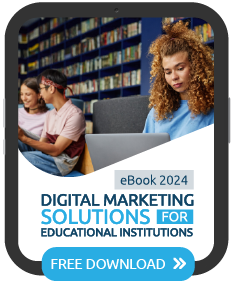
Mobile is increasingly where your target prospective students spend their time.
Current statistics indicate that in the US mobile devices (phone and tablet) account for approximately 27% or more of the site traffic to college and university websites and that number continues to increase.
Driving this increase in traffic from mobile devices are increasing numbers of educational search queries using both general program keywords and specific branded (institution’s formal names) keywords. All things being equal, you should also be seeing similar performance increases in your mobile analytics goals, lead generation and student registrations from mobile lead sources.
If that is true, congratulations, you’re already a mobile education lead generation super star. If you are not quite there yet, here are seven tips to consider to help you optimize your digital marketing for the mobile device user.
1) Use a mobile-first design approach
Google’s recent algorithm change specifically ranks sites higher that are mobile friendly. That means that your site will rank higher if you have a mobile (responsive or mobile specific) site vs an old-school desktop only design. The bottom line is, get responsive or you will be left behind in search by your competition’s sites.
Once you have made that shift in thinking it’s time to adopt a mobile–first strategy. This makes it much easier to make the full conceptual leap to mobile. Everything is a little different in the mobile world so if you adopt a mobile first mentality it will help drive the necessary changes through your design, content and marketing strategy. This includes making fundamental changes in your thinking like leading with primary content, using vertical vs horizontal design, using minimum graphics, minimum footers, and fewer page links, etc.
2) Content on mobile must be different
Space limitations on mobile requires a different approach to content but unfortunately a lot of migrations to responsive simply take all the existing desktop content and push it out in a different “shape” producing long and ungainly pages. Mobile requires that you simplify your content goals, including reducing content and emphasizing location, contact and action.
3) Use unique mobile page functionality
Mobile pages present many challenges that require the reduction of content, and simplification of design but they also provide options not available on desktop, like geolocation features and functions and integrated click to call, for example. Mobile technology and format requires that you rethink page functionality, eliminating some things, adding others and redesigning for other things, i.e call to action buttons for fat fingers (or paws).

4) Master mobile SEO by thinking local
Responsive or mobile only design provides a first requirement for effective mobile SEO. Your pages also require all of the other generally understood SEO factors, like good titles, keyword rich H1s, image tags etc. but you must additionally push your SEO practice into the context of SEO for local search. To test this concept, do a search for one of your programs on a desktop and then on a mobile device and you will see, how in some cases the differences in search results are significant.
5) Mobile PPC converts differently
PPC on mobile is attractive for many reasons. It typically has a lower cost-per-click price than desktop PPC, there are fewer ad positions to compete with, and it offers direct response options with click to call functionality, to name a few things. While offering some advantages, mobile PPC is a very different medium from desktop and it must be managed carefully, and with different expectations. Conversion rates are often lower and lead quality often differs significantly from that which you may be experienced with on the desktop side.
6) Social media marketing was made for mobile
Social media marketing, when done with the right goals and managed effectively can be an excellent driver of web traffic and prospective students. Social media campaigns on mobile are a natural fit but you must approach them with reasonable goals and expectations. Social media, content marketing and SEO are intimately related and must be managed and measured as such. Pick your spots carefully and learn from experience what works for you.
7) If you can’t measure it, you can’t manage it

Mobile lead generation and recruitment marketing on mobile can be surprisingly different from that on the desktop. From our experience working with educational institutions, from private high schools all the way up to MBA and Graduate program marketing, we have learned much that can be generalized across the marketplace but also can definitively report that what works for one school in one segment can also turn out to be a complete bust for someone else in a different niche. The only way to effectively manage these kinds of results is to plan campaigns very carefully, with discrete measureable objectives, and then learn from your results in a very lean, agile manner. Use your website and social media analytics tools to track and analyze your progress and keep improving the quality and the ROI of your marketing.
Conclusion
We hope that using these tips you will increase your traffic, better communicate your marketing message, generate more leads and register more students. Give them a try and we’ll see you on the red carpet!
What have the biggest challenges been for you, as you have moved your marketing into the mobile world? What tactics have proven most valuable to you? What other lessons would you like to share with our readers about your experiences in mobile?






